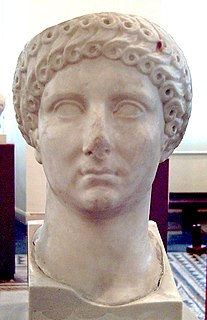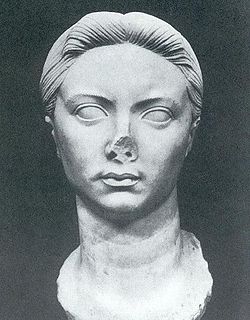Related Research Articles

Agrippina the Elder, commonly referred to as "Agrippina the Elder", was a prominent member of the Julio-Claudian dynasty. She was born in c. 14 BC the daughter of Marcus Vipsanius Agrippa, a close supporter of Rome's first emperor Augustus, and Augustus' daughter Julia the Elder. At the time of her birth, her brothers Lucius and Gaius were the adoptive sons of Augustus and were his heirs until their deaths in AD 2 and 4, respectively. Following their deaths, her cousin Germanicus was made the adoptive son of Tiberius as part of Augustus' succession scheme in the adoptions of AD 4 in which Tiberius was adopted by Augustus. As a corollary to the adoption, Agrippina was wed to Germanicus in order to bring him closer to the Julian family.

Agrippina the Younger, also referred to as Agrippina Minor, was a Roman empress and one of the more prominent women in the Julio-Claudian dynasty. Her father was Germanicus, a popular general and one-time heir apparent to the Roman Empire under Tiberius; and her mother was Agrippina the Elder, a granddaughter of the first Roman emperor Augustus. She was also the younger sister of Caligula, as well as the niece and fourth wife of Claudius.

Caligula was Roman emperor from 37 to 41 AD. The son of the popular Roman general Germanicus and Augustus's granddaughter Agrippina the Elder, Caligula was born into the first ruling family of the Roman Empire, conventionally known as the Julio-Claudian dynasty. Germanicus's uncle and adoptive father, Tiberius, succeeded Augustus as emperor of Rome in 14 AD.

Nero was the last Roman emperor of the Julio-Claudian dynasty. He was adopted by his great-uncle Claudius and became Claudius' heir and successor. Like Claudius, Nero became emperor with the consent of the Praetorian Guard. Nero's mother, Agrippina the Younger, dominated Nero's early life and decisions until he cast her off and had her killed five years into his reign.

Tiberius was the second Roman emperor, reigning from 14 AD to 37 AD. He succeeded his stepfather, Augustus.

Tiberius Claudius Caesar Britannicus, usually called Britannicus, was the son of Roman emperor Claudius and his third wife Valeria Messalina. For a time he was considered his father's heir, but that changed after his mother's downfall in 48, when it was revealed she had engaged in a bigamous marriage without Claudius' knowledge. The next year, his father married Agrippina the Younger, Claudius' fourth and final marriage. Their marriage was followed by the adoption of Agrippina's son, Lucius Domitius, whose name became Nero as a result. His step-brother would later be married to his sister Octavia, and soon eclipsed him as Claudius' heir. Following his father's death in October 54, Nero became emperor. The sudden death of Britannicus shortly before his fourteenth birthday is reported by all extant sources as being the result of poisoning on Nero's orders—as Claudius' natural son, he represented a threat to Nero's claim to the throne.

Lucius Aelius Sejanus, alternatively spelled Seianus, commonly known as Sejanus, was an ambitious soldier, friend and confidant of the Roman Emperor Tiberius. An equestrian by birth, Sejanus rose to power as prefect of the Roman imperial bodyguard, known as the Praetorian Guard, of which he was commander from AD 14 until his death in AD 31.

Poppaea Sabina —known as Poppaea Sabina the Younger and, after AD 63, as Poppaea Augusta Sabina—was a Roman Empress as the second wife of the Emperor Nero. She had also been wife to the future Emperor Otho. The historians of antiquity describe her as a beautiful woman who used intrigues to become empress.
Claudia Livia Julia was the only daughter of Nero Claudius Drusus and Antonia Minor and sister of the Roman Emperor Claudius and general Germanicus, and thus the paternal aunt of the emperor Caligula and maternal great-aunt of emperor Nero, as well as the niece and daughter-in-law of Tiberius. She was named after her grandmother, Augustus' wife Livia Drusilla, and commonly known by her family nickname Livilla. She was born after Germanicus and before Claudius.

Drusus Caesar was the adopted grandson and heir of the Roman Emperor Tiberius, alongside his brother Nero. Born into the prominent Julio Claudian dynasty, Drusus was the son of Tiberius' general and heir, Germanicus. After the deaths of his father and of Tiberius' son, Drusus the Younger, Drusus and his brother Nero Julius Caesar were adopted together by Tiberius in September AD 23. As a result of being heirs of the emperor, he and his brother enjoyed accelerated political careers.
Gaius Asinius Gallus Saloninus was the son of Gaius Asinius Pollio, consul in 40 BC, and Quinctia. He is best known as the second husband of Vipsania, eldest daughter of Marcus Vipsanius Agrippa and first wife of Tiberius, who ultimately imprisoned him.

Vipsania Agrippina was the first wife of the Emperor Tiberius. She was the daughter of Marcus Vipsanius Agrippa and Pomponia Caecilia Attica, thus a granddaughter of Titus Pomponius Atticus. By marriage, she was also a great-niece to Quintus Tullius Cicero.

Nero Julius Caesar Germanicus was the adopted grandson and heir of the Roman Emperor Tiberius, alongside his brother Drusus. Born into the prominent Julio-Claudian dynasty, Nero was the son of Tiberius' general and heir, Germanicus. After the deaths of his father and of Tiberius' son, Drusus the Younger, Nero and his brother Drusus were adopted together by Tiberius in September AD 23. As a result of being heirs of the emperor, he and his brother enjoyed accelerated political careers.
Pomponia Graecina was a noble Roman woman of the 1st century who was related to the Julio-Claudian dynasty. She was the wife of Aulus Plautius, the general who led the Roman conquest of Britain in 43 AD, and was renowned as one of the few people who dared to publicly mourn the death of a kinswoman killed by the Imperial family. It has been speculated that she was an early Christian. She is identified by some as Lucina or Lucy, a saint honoured by the Roman Catholic Church.
Acerronia Polla was a servant and friend of Agrippina the Younger, the mother of Nero. She was drowned in AD 59, when an unsuccessful attempt was made at the same time to drown Agrippina. She may have been the daughter of Gnaeus Acerronius Proculus, consul in AD 37.
Gnaeus Acerronius Proculus was a consul of the Roman Empire in 37 AD, with Gaius Petronius Pontius Nigrinus as his colleague; that was the year Tiberius died.
Halotus was a servant to the Roman Emperor Claudius, the fourth member of the Julio-Claudian dynasty. He served Claudius as a taster and as a chief steward; it was because of his occupation, which entailed close contact with Claudius, that he is and was a suspect in the murder of the latter by poison. Along with Agrippina the Younger, the wife of Claudius, Halotus was considered one of the most likely to have committed the murder, although speculation by ancient historians suggest that he may have been working under orders of Agrippina.

Gaius Silius was a Roman senator who was nominated as consul designate for 49 AD, but was executed by the emperor Claudius for his affair with the empress Valeria Messalina.
The gens Crepereia was a plebeian family of equestrian rank at ancient Rome. The family appears in history from the first century BC to the first or second century AD. Cicero describes the strict discipline of the Crepereii.
Anicetus was a freedman of the Roman emperor Nero, who – along with the freedman Beryllus – tutored the young emperor.